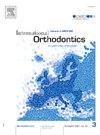Treatment for adult female temporomandibular joint osteoarthritis-related severe retrognathia and anterior open bite using premolar extraction and customized lingual orthodontic appliance with vertical control for significant compensation: A case report
IF 1.9
Q2 DENTISTRY, ORAL SURGERY & MEDICINE
引用次数: 0
Abstract
This case report presents a satisfactory lingual appliance orthodontic treatment in a 21-year-old woman diagnosed with Angle Class I anterior open bite (AOB) malocclusion and severe high-angle skeletal Class II retrognathia, which was attributed to bilateral temporomandibular osteoarthritis (TMJOA) and disc perforation. Because of the absence of joint symptoms and presence of bilateral condyles in a stable state, no conservative or surgical treatments were performed for this patient. Four first premolars and four third molars were extracted before bonding of the customized lingual brackets. No miniscrews were used during the orthodontic process. Space closure was performed using the double cable method. Finally, the maxillary molars were found to have intruded and moved mesially during the space-closing process, which resulted in a 2.9° decrease in the mandibular plane angle. Owing to the counter-clockwise rotation of the mandible, the chin moved anteriorly and superiorly. In addition, the anterior teeth were largely retracted because of the advantage of this customized lingual appliance, resulting in significant changes in the nasolabial angle and chin contour. Two-year follow-up examinations further confirmed that no obvious relapse in occlusion and no further condylar resorption, even though bilateral anterior disc displacement without reduction was revealed. In conclusion, a patient with TMJOA-related severe chin retrognathia and AOB treated with a lingual appliance showed satisfactory improvement in facial profile and occlusion.
采用前磨牙拔牙和定制化舌正畸矫治器垂直控制显著补偿治疗成年女性颞下颌关节骨关节炎相关严重颌后突和前开咬1例
本病例报告报告了一名21岁的女性,诊断为角I类前开咬(AOB)错颌和严重的高角骨骼II类后颌,其原因是双侧颞下颌骨关节炎(TMJOA)和椎间盘穿孔,舌矫治治疗令人满意。由于无关节症状且双侧髁处于稳定状态,该患者未接受保守治疗或手术治疗。拔除四颗第一前磨牙和四颗第三磨牙,然后进行定制舌托的粘接。在正畸过程中没有使用微型螺钉。采用双索法封闭空间。最后发现上颌磨牙在合腔过程中向内侵入移动,导致下颌平面角下降2.9°。由于下颌骨逆时针旋转,下巴向前上移动。此外,由于这种定制的舌器的优势,前牙大量缩回,导致鼻唇角和下巴轮廓发生明显变化。两年的随访检查进一步证实,即使发现双侧前盘移位但未复位,但未出现明显的闭塞复发和进一步的髁骨吸收。结论:1例颞下颌关节关节炎相关性重度颌后畸形合并AOB患者经舌矫治器治疗后,面部轮廓和咬合均有满意的改善。
本文章由计算机程序翻译,如有差异,请以英文原文为准。
求助全文
约1分钟内获得全文
求助全文
来源期刊

International Orthodontics
DENTISTRY, ORAL SURGERY & MEDICINE-
CiteScore
2.50
自引率
13.30%
发文量
71
审稿时长
26 days
期刊介绍:
Une revue de référence dans le domaine de orthodontie et des disciplines frontières Your reference in dentofacial orthopedics International Orthodontics adresse aux orthodontistes, aux dentistes, aux stomatologistes, aux chirurgiens maxillo-faciaux et aux plasticiens de la face, ainsi quà leurs assistant(e)s. International Orthodontics is addressed to orthodontists, dentists, stomatologists, maxillofacial surgeons and facial plastic surgeons, as well as their assistants.
 求助内容:
求助内容: 应助结果提醒方式:
应助结果提醒方式:


